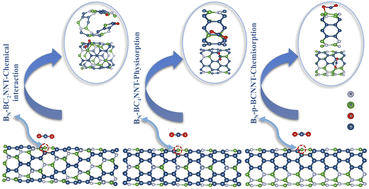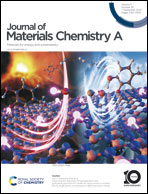Boron-rich enhanced ambient CO2 capture and storage of boron–carbon–nitride hybrid nanotubes†
Abstract
Increasing carbon dioxide (CO2) emissions as the most challenging greenhouse gas is considered as a major cause of global warming and ocean acidification. Different strategies against anthropogenic emissions of CO2 have been applied to capture and reduce the CO2 effect on the atmosphere. To this end, we study the adsorption of CO2 on boron-rich structures of boron–carbon–nitride (BCN) hybrid nanotubes by the implementation of an ab initio approach based on density functional theory (DFT). Three different boron-rich BC2N, BC4N, and parallel BCN (p-BCN) nanotubes are investigated as hosts for the capture and sequestration of CO2. The analysis of calculations shows that the boron-rich BC4N nanotube adsorbs CO2 physically, while in the boron-rich BC2N and p-BCN nanotubes, both chemisorption and physisorption occurred. In the chemisorption process, a linear CO2 molecule is bent over, and a new bond is formed between oxygen and boron antisite (BN) in boron-rich nanotubes due to electron back donation between CO2 and nanotubes as a result of orbital mixing of oxygen and boron atoms. Moreover, our findings show that the sensitivity factor (SF) and adsorption energy for boron-rich BC2N nanotubes are higher than those of other hybrid nanotubes and CO2 free energy at room temperature. Elaborating on the stability and recycling of host material challenges suggests that the boron-rich hybrid nanotubes could be a good candidate for capturing CO2 under ambient conditions.

- This article is part of the themed collections: 1D/2D materials for energy, medicine, and devices and #MyFirstJMCA


 Please wait while we load your content...
Please wait while we load your content...